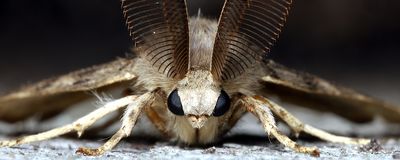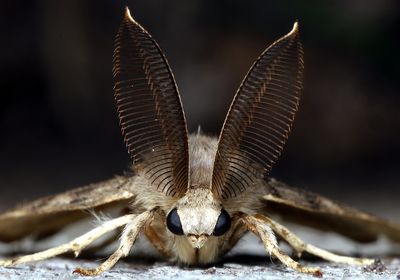ABOVE: Lymantria species make ultrasonic, mechanical rasping noises when they hear bats nearby. © ISTOCK.COM, HEATHER BROCCARD-BELL
Spending months in hostels in far-flung locales is more often the province of graduate students than of established researchers. But it’s been the side project of a lifetime for Jesse Barber and Akito Kawahara, two scientists who have spent more than a decade crisscrossing continents to catch moths, play bat sounds at them, and see if—and how—they squeak back.
Like other nocturnal insects, moths need to contend with bats. Unlike grasshoppers or beetles, they have soft bodies without spines or hard cuticles to protect them. Yet bats’ reliance on echolocation has given moths a way to avoid ending up as food: by tapping into their predators’ acoustic signals. Many have evolved ears that can hear the calls of bats. Some moths make ultrasonic squeaks, chirps, or clicks to warn their predators (honestly or not) that they are poisonous. Others generate near-constant, ultrasonic buzzes capable of jamming bat sonar.
While such abilities have been documented in a range of moths, it’s less clear whether these behaviors are rare evolutionary quirks or common strategies across the 160,000 or so moth species worldwide. Barber, a sensory ecologist at Boise State University, and Kawahara, an entomologist at the Florida Museum of Natural History, have been thinking about this mystery since they first crossed paths about 17 years ago at a Lepidopterists’ Society meeting in Sierra Vista, Arizona—a gathering that Barber describes as “a raging good time.” During the course of the doctoral work he’d just completed, Barber had stumbled across a quirk of moth behavior: Some hawkmoths (family Sphingidae) respond to recordings of bat echolocation by squeaking back at them, though it wasn’t immediately clear why.

To find out more, “we got a grant to study that system and started traveling around the world, just the two of us, staying in hostels, catching moths and playing bat sounds back at them,” Barber says. The pair would attract moths with ultraviolet light, gently hold smaller moths down with locking forceps or use fishing line to tether larger moths so that they could fly but not escape, and play prerecorded bat sonar through an ultrasonic speaker. Moths responded with all sorts of sounds of their own, which the pair recorded. The large Gonodonta bidens, for example, made a short, light buzz that, when slowed down, sounds like a small handful of rice being poured into a plastic container, while the mechanical rasps of Lymantria species sounded more like the noise made by a rattlesnake.
Over roughly the next decade, Barber says, “we went to French Guiana at least five times, Borneo at least five times; we went to Mozambique a couple of times, Ecuador a couple of times,” among other places, roping in more and more graduate students as they went. “We were just doing it as a side project as other grants and projects carried us around the world,” he explains, “so it was kind of pieced together over time.”
After testing 252 genera across most of the 28 large-bodied moth families—those that are big enough to be capable of making a sound bats can hear from a distance— the researchers documented anti-bat ultrasound production as a form of warning signal of poisonous qualities in 52 genera. They also found evidence that sonar-jamming strategies had evolved independently multiple times—at least twice in hawkmoths and four times in the Erebidae family—and noted overlap between species that signal and species that jam. Interestingly, many of the moths appeared to be converging on similar sounds, Barber says.
Bats’ reliance on echolocation has given moths a way to avoid ending up as food.
Investigating a community of moths in Ecuador, Barber and Kawahara also found evidence of complex acoustic mimicry, featuring various combinations of moths—some jammers, some warners, some that do both, and some that make warning noises even though they aren’t poisonous—all copying one another’s signals. “[It] is likely that ultrasonically signaling moths comprise one of the largest mimicry complexes on earth,” the authors write in their paper.
University of Bristol behavioral and sensory ecologist Marc Holderied, who was not involved in the work, says that while researchers knew that bats and moths were in an “acoustic arms race,” this paper provides new information on the distribution of these strategies across moth species. “This is a very nice piece of research, and it’s well executed. . . . It’s something that needed to be done and it’s been done very well,” he says, adding that “the chapter on these acoustic signals has just increased in volume multifold.” The findings on multiple convergent acoustic mimicry strategies is particularly interesting, he says. “What in the bats’ brain makes this particular signal so efficient in protecting the prey?”
Now-retired behavioral ecologist Michael Greenfield, formerly of the University of Kansas, compliments the collaborative nature of the project. “When I started in ecology and evolution, it was the era of the rugged individual” and single-author publications, he says. But in this paper the authors “made use of having a team: people [were] testing on different continents, on many different species,” which made a paper of this scale possible. Greenfield also notes that while Barber, Kawahara, and colleagues uncovered many novel examples of sound-producing moths, most were found in four superfamilies where they had already been documented.
Athanasios Ntelezos, a graduate student in zoology and electrophysiology at the University of Cambridge, writes in an email to The Scientist that while the paper adds to scientists’ understanding of “how widespread this strategy is,” he would have liked to see data on the effects of moths’ signals. “Ideally one would want to test the function of the sounds produced by moths by pitting them against bats and comparing the effectiveness of the sound-producing group to that of a control group,” he says, but “the new study is large-scale and [it] would be very hard indeed to test each moth species against bats.”
The project has certainly been a massive undertaking, Barber says. “A lot of the reason it took us so long to publish it [was that] we felt the story was so incomplete that, what could we say?” After all, “to sample enough animals in a phylogeny this diverse, with this many species, is a lifetime task.” Yet the result is a testament not only to a legion of collaborators the world over, but to a long-standing friendship and partnership, and the passion of everyone involved, he adds. “Something I can say about the entire list of authors: we all love moths. And, you know, that’s sort of the type of scientist and person you have to be to delve this deeply into this question without getting paid to do it.”








